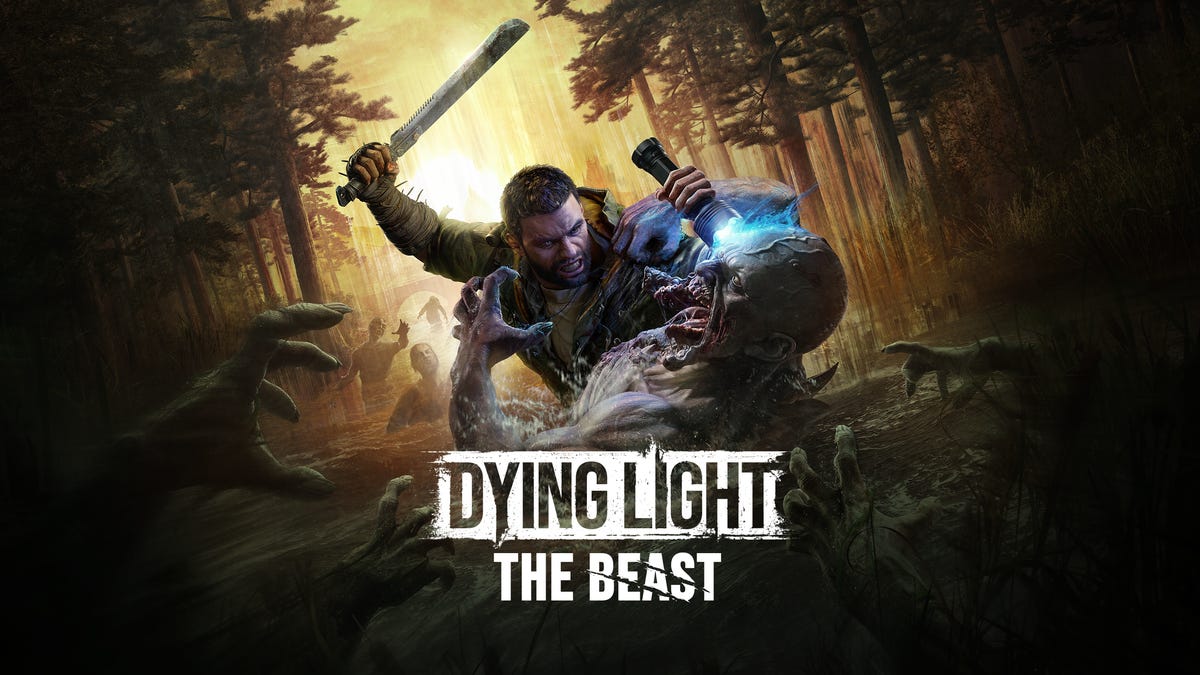Technologies
Dying Light: The Beast Hands-On: Brutal Survival in a Zombie-Ridden Forest
I got to preview Techland’s next entry in its Dying Light series, which brings the parkour zombie horror to the great outdoors.

Two hours into my gaming preview of Dying Light: The Beast, I was jogging through a beautiful woodland dotted with cabins and park benches — a spot that would make for a lovely vacation, if not for the hordes of zombies wandering all over. Despite stealthily creeping around, I was spotted by a large group and frantically fended them off with a shovel, growing more desperate and overwhelmed — until my rage meter maxed out and I became a beast. I roared and tore the zombies limb from limb until the red haze lifted from my vision, leaving me human again to continue my journey through the park.
At a preview event in Los Angeles, California, Polish studio Techland set me and other media members up to play the first few hours of Dying Light: The Beast. It’s the next entry in the beloved Dying Light series of games, which combine first-person parkour movement with zombie horror action. After the long gap between the 2015 original and its 2022 sequel Dying Light 2 Stay Human, the third game is coming out just three years later, with a release date of August 22, 2025. Dying Light: The Beast is a course correction that brings back more of the horror and vulnerability that made the first game so successful, Dying Light franchise director Tymon Smektala told me.
«Wtih Dying Light: The Beast, we want to recapture that fear, that horror, that tension that the first game had,» Smektala said. «Maybe it was beginner’s luck, but we actually managed to capture the atmosphere and the feel and the balance just right.»
Part of that is bringing back the first game’s protagonist, Kyle Crane, who has been locked away for a decade while the zombie plague he once tried to contain rampages across the world. After escaping an underground lab, Crane quickly discovers that years of experiments done on him have left him with bursts of strength and bloodlust, which comes in handy when he’s beset by mutated enemies — he becomes a monster to fight monsters.
Prior Dying Light games let players explore open-world cities with free-roaming parkour movement, leaping over railings and climbing up fire escapes. The Beast expands this to a seemingly less suitable environment: Castor Woods, a sprawling forest that feels like a national park, where players have to thread their way through woodlands, rivers, mountain paths and other terrain. Techland challenged itself to see if the series’ parkour movement to evade zombies rather than fight them all would work in different biomes, Smektala said — and he believes they’ve cooked up something unique that pushes players to change how they move and deal with the living and the dead.
«So you could say, ‘okay, maybe I can hide behind trees and try to use how dense the forest is to lose the chase,’ but on the other hand, you never really know what you can find behind that tree, what hides in those forests,» Smektala said. «We like the fact that there are places on the map where you basically feel weaker, where you feel more fragile.»
Swinging between fragility and «Beast Mode» revenge
In my handful of hours with The Beast, I frequently felt that sense of vulnerability, confidently taking on a couple zombies, only to get cornered by half a dozen more shambling up behind me. Combat feels slow and weighty, relying on timing to avoid exhausting myself. I had to circle enemies carefully and slip between their attacks as my melee swings gradually took them down one by one — with guns and bullets scarce, at least early on.
But when I’d hit (or had been hit) enough to fill my rage meter, the game’s unique mechanic, Beast Mode, activated turning me into a monstrous force of nature, battering zombies and ripping off their limbs (if not worse — the game’s brutal dismemberment isn’t for the weak-stomached). Beast Mode is a deliberate counterbalance for handling hordes and turning the tides in combat — partially inspired, surprisingly, by the classic game Pac-Man.
«Pac-Man, if you think about it, is actually also a survival game where you are chased by ghosts. You are super weak, just one touch and you die — but there are those power pellet moments, you grab them and suddenly you can start chasing ghosts,» Smektala said, comparing that «cathartic overpower state» to the new Dying Light’s Beast Mode.
To make sure these moments land when they’re most needed, Techland has made under-the-hood tweaks, including filling the Beast Mode meter faster when the player is surrounded by zombies or when being chased by an undead horde at night (more on that later). The game keeps these mechanics hidden, Smektala explained, to prevent players from gaming the system. They’re designed to heighten the thrill of pursuit and reversal — fine-tuned through extensive player testing.
«You really feel like these are your last moments, the zombies are coming at you … and they’re just about to grab you and suddenly you see that meter has been charged and then you can turn 180 and get that moment of resetting the situation,» Smektala said.
Beast Mode isn’t the only escape route. Unlike the second Dying Light game where players can paraglide between buildings, The Beast’s national park areas are too broad for aerial traversal — but I could jump into abandoned vehicles and drive away from sticky situations… at least until the gas ran out. (You can refuel at select spots and unlock skills to burn less fuel.)
Whether you’re smashing zombies with improvised weapons, tearing through them in Beast Mode or mowing them down in a car, the game’s brutality is unmistakable — and it’s been dialed up since the last Dying Light, thanks to further optimizations to Techland’s in-house C-Engine. For The Beast, the studio has doubled the number of possible wounds zombies can take, so whether you strike the head or midsection, you’ll see injuries that match.
Techland also went all-in on realistic blood spatters rendered by C-Engine: Artists ordered liters of fake blood and spent days creating real-life splats to digitize for the game.
«So if you enter a room [in the game] and you see blood dragging on the floor or a blood splat on the wall, actually there was an actor in our mock-up studio that was dragging his body on the floor to leave that mark, and then we just scanned it and put it into the game,» Smektala said.
Surviving the least relaxing vacation of your life
My preview started an hour or so into Dying Light: The Beast, after Crane escapes from the underground facility. He’s woken up in the territory of The Baron, a sadistic noble ruling over the national park-like territory in an unspecified European country — one inspired by Swiss landscapes, a Techland developer told me. His small army of soldiers roam the land doing his bidding, adding another hazard standing between Crane and escape, but they’re far from the worst things in this strange land.
After escaping the facility, Crane wanders down a mountain trail to find a monastery that he clears of zombies to turn into a safe house. But his final task is to face a mutated monstrosity with a gas mask — the game’s first boss. After putting it in the ground, a scientist named Olivia introduces herself and pledges to help Crane. She takes a blood sample from the creature and convinces Crane to administer it to himself, granting him the upgrade to his Beast Mode.
These monsters, which Olivia calls Chimeras, are the faulty results of The Baron’s experiments. They roam the woodlands and she urges Crane to hunt them down to grow stronger so he can defeat the psychopathic noble. Each new kill grants a point in the Beast Mode skill tree, unlocking bonuses and new abilities like a ground slam.
After that, the game opens up, allowing players to alternate between following the main story or side quests and engaging with the game’s open world — exploring territory, gathering supplies and weapons and establishing safe houses to rest and recover. The safe houses are key to waiting out the dangerous dark hours, as the day-night cycle from Dying Light’s earlier games returns. When the sun sets, powerful nocturnal ghouls called Volatiles emerge. If alerted, they’ll unleash zombie hordes in a chase sequence that only ends with clever evasion — or reaching a safe house.
While players can simply sleep through the night, certain treasure-laden zombies only emerge after twilight, and I imagine other incentives or missions will lure players out of their safe houses.
Nighttime also becomes more manageable as players get stronger, either through acquiring equipment or leveling up — killing enemies will give Crane a bit of experience, while finishing story missions will award a lot. Every level grants a skill point to improve Crane’s stealth, parkour or combat abilities, which are important to gather to handle some of the game’s tougher enemies, from zombies in combat armor to Chimeras encountered in the wild.
As players explore and fill in the map, they’ll find some areas have level thresholds. I was driving around when I spotted an intriguing building across the river — an abandoned mental hospital likely full of loot — but it was 8 or 9 levels above me, and I didn’t want to risk it. You can offset level gaps with gear: Weapons are scattered throughout the world, with rarer loot hidden in riskier spots — like the military convoy I cleared out to score higher-level equipment.
Other weapons must be crafted, and there’s a cornucopia of materials scattered around, some that you’ll pick up off the ground and others scavenged from defeated zombies. You’ll need blueprints to make key weapons — I found one for a bow in the starting monastery safe house — and yes, once I built it, I needed to craft the arrows, too.
Becoming your own Beast
With a sprawling map to explore, crafting and skill trees, Dying Light: The Beast felt like a familiar yet fun mashup of Far Cry and Mirror’s Edge, all set in lovely woodland scenery (as an outdoorsy person, I’m partial to the natural setting, though there is a town in the game to provide some urban parkouring). Combined with the day-night cycle and a story pitting survivors against the vicious Baron, open-world game fans have a lot to chew on in Techland’s upcoming game — especially those who want a bit more of a challenge in their combat.
To ameliorate that difficulty, The Beast offers co-op mode, letting players team up with up to three friends. But teaming up won’t make the game instantly easier, as Techland made sure to adjust the game’s challenge accordingly, from spawning more zombies and making them stronger to giving them area-of-attack swipes to hurt multiple teammates. The Chimeras will be especially beefed up — so much so that players may not be able to take them down solo when playing with others in a game session.
A couple hours into the preview, after taking down a pair of hulking Chimeras, I was tasked with chasing down a third in a swamp. This fiend was different — a spindly blood-soaked ghoul that reminded me of the fearsome Witch special enemy from the Left 4 Dead games. She dashed in and out of the foggy marshland, and I struggled to track her and land hits while dodging her own — barely eking out a win thanks to some clutch Beast Mode transformations.
When I next took on a hefty Chimera with a concrete slab for an arm that I encountered after delving into the train tunnels, it became clear Techland had designed each of these fights as its own unique arena brawl. I was down in the depths, hunting an especially lethal monster that had been terrorizing survivors, and that Chimera wasn’t it. After chasing down the culprit, I pulled back the hood to reveal a familiar face — Crane’s own. Another failed experiment, maybe? As my preview ended, I was left wondering what The Beast truly referred to.
As I stepped away, I could feel the game’s open-world hooks sinking in — I just wanted to craft one more weapon, secure one more safe house, hunt one more Chimera and push past the edge of my map.
Dying Light: The Beast launches on August 22 for PC, PS5 and Xbox One X/S.
Technologies
Today’s NYT Strands Hints, Answers and Help for Dec. 25 #662
Here are hints and answers for the NYT Strands puzzle for Dec. 25, No. 662.

Looking for the most recent Strands answer? Click here for our daily Strands hints, as well as our daily answers and hints for The New York Times Mini Crossword, Wordle, Connections and Connections: Sports Edition puzzles.
Today’s NYT Strands puzzle has a holiday theme, and if you know a certain Christmas carol, you’ll quickly determine which words to hunt down. Some of the answers are difficult to unscramble, so if you need hints and answers, read on.
I go into depth about the rules for Strands in this story.
If you’re looking for today’s Wordle, Connections and Mini Crossword answers, you can visit CNET’s NYT puzzle hints page.
Read more: NYT Connections Turns 1: These Are the 5 Toughest Puzzles So Far
Hint for today’s Strands puzzle
Today’s Strands theme is: Carolers count.
If that doesn’t help you, here’s a clue: Five golden rings.
Clue words to unlock in-game hints
Your goal is to find hidden words that fit the puzzle’s theme. If you’re stuck, find any words you can. Every time you find three words of four letters or more, Strands will reveal one of the theme words. These are the words I used to get those hints but any words of four or more letters that you find will work:
- RIMS, HIMS, MARS, CHIME, CHIMES, MADS, DATE, DIAL, WAIL
Answers for today’s Strands puzzle
These are the answers that tie into the theme. The goal of the puzzle is to find them all, including the spangram, a theme word that reaches from one side of the puzzle to the other. When you have all of them (I originally thought there were always eight but learned that the number can vary), every letter on the board will be used. Here are the nonspangram answers:
- LORDS, MAIDS, SWANS, LADIES, PIPERS, DRUMMERS
Today’s Strands spangram
Today’s Strands spangram is CHRISTMASDAYS. To find it, look for the C that’s three letters down on the far-left row, and wind across.
Don’t miss any of our unbiased tech content and lab-based reviews. Add CNET as a preferred Google source.
Toughest Strands puzzles
Here are some of the Strands topics I’ve found to be the toughest in recent weeks.
#1: Dated slang, Jan. 21. Maybe you didn’t even use this lingo when it was cool. Toughest word: PHAT.
#2: Thar she blows! Jan.15. I guess marine biologists might ace this one. Toughest word: BALEEN or RIGHT.
#3: Off the hook, Jan. 9. Similar to the Jan. 15 puzzle in that it helps to know a lot about sea creatures. Sorry, Charlie. Toughest word: BIGEYE or SKIPJACK.
Technologies
Judge Blocks Texas App Store Age-Check Law
A preliminary injunction found the Texas law, set to begin Jan. 1, is «more likely than not unconstitutional.»

A new Texas state law set to take effect on Jan. 1 would have required app stores to implement age verification processes. But the law has been put on hold, at least temporarily, by a federal court judge.
As reported by the Texas Tribune, Senate Bill 2420, also known as the Texas App Store Accountability Act, is the subject of a temporary injunction issued by US District Judge Robert Pitman.
Pitman said in his decision that the law as written is broad, vague and «more likely than not unconstitutional.» However, he also wrote the court «recognizes the importance of ongoing efforts to better safeguard children when they are on their devices.»
Don’t miss any of our unbiased tech content and lab-based reviews. Add CNET as a preferred Google source.
The Texas law, signed into law by Governor Greg Abbott in May, requires app store operators — including Apple, Google, Nintendo, Steam and more — to build age verification processes for the storefronts and to only allow downloads to minors who obtain parental consent. The injunction is a ruling in an October lawsuit filed by the Computer & Communication Industry Association.
CCIA senior vice president Stephanie Joyce said in a statement, «This Order stops the Texas App Store Accountability Act from taking effect in order to preserve the First Amendment rights of app stores, app developers, parents, and younger internet users. It also protects parents’ inviolate right to use their own judgment in safeguarding their children online using the myriad tools our members provide.»
Other individuals and the advocacy group Students Engaged in Advancing Texas also filed suits over the law, the Texas Tribune reported.
App Store Accountability Act
The bill author, State Senator Angela Paxton, said the bill was meant to give parents «common sense tools to protect their kids and to survive court challenges by those who may have lesser priorities.»
The language of Texas Senate Bill 2420 does not only include mobile app stores from Apple or Google, but any «website, software application, or other electronic service that distributes software applications from the owner or developer of a software application to the user of a mobile device.»
By that definition, websites with links to browser games or mobile game consoles with download options would fall under the Texas law as written. The law also defines mobile devices as including phones and tablets, as well as any other handheld device capable of transmitting or storing information wirelessly.
The parental consent aspect of the law requires those under 18 to have an app store account affiliated with a parent or guardian to purchase or download applications.
Age verification elsewhere
In an effort to keep adult materials out of reach of minors and to protect children from potentially harmful content and interactions, tech companies have been compelled by law or through legal action to verify the age of users.
Roblox, which has a huge audience of minors, began rolling out stricter age verification after investigations and lawsuits hurt its reputation as a safe gaming space. Australia is perhaps the most large-scale example of a government restricting access to online content. In December, Australia began restricting social media access to those 16 and older. Reddit recently challenged that law.
In the US, age verification laws have primarily targeted adult sites. Texas already has a law on the books that requires adult sites to age-block their content. The Supreme Court upheld that law in a June ruling. The UK has also enacted age restriction rules for adult sites as have other US states.
Technologies
Today’s NYT Mini Crossword Answers for Thursday, Dec. 25
Here are the answers for The New York Times Mini Crossword for Dec. 25.

Looking for the most recent Mini Crossword answer? Click here for today’s Mini Crossword hints, as well as our daily answers and hints for The New York Times Wordle, Strands, Connections and Connections: Sports Edition puzzles.
Need some help with today’s Mini Crossword? Of course, there’s a very Christmassy clue involved. And once you solve the entire puzzle, look at the letters used in all the answers and see what they have in common. (5-Across will tell you!) Read on for all the answers. And if you could use some hints and guidance for daily solving, check out our Mini Crossword tips.
If you’re looking for today’s Wordle, Connections, Connections: Sports Edition and Strands answers, you can visit CNET’s NYT puzzle hints page.
Read more: Tips and Tricks for Solving The New York Times Mini Crossword
Let’s get to those Mini Crossword clues and answers.
Mini across clues and answers
1A clue: ___ King Cole, singer with the album «The Magic of Christmas»
Answer: NAT
4A clue: Body drawings, informally
Answer: TATS
5A clue: Letters to ___ (what this Mini was made with)
Answer: SANTA
6A clue: Huge fan, in slang
Answer: STAN
7A clue: «Illmatic» rapper
Answer: NAS
Mini down clues and answers
1D clue: Grandmothers, by another name
Answer: NANAS
2D clue: Abbr. before a name on a memo
Answer: ATTN
3D clue: Org. with long lines around the holidays
Answer: TSA
4D clue: «See ya later!»
Answer: TATA
5D clue: Govt.-issued ID
Answer: SSN
Don’t miss any of our unbiased tech content and lab-based reviews. Add CNET as a preferred Google source.
-

 Technologies3 года ago
Technologies3 года agoTech Companies Need to Be Held Accountable for Security, Experts Say
-

 Technologies3 года ago
Technologies3 года agoBest Handheld Game Console in 2023
-

 Technologies3 года ago
Technologies3 года agoTighten Up Your VR Game With the Best Head Straps for Quest 2
-

 Technologies4 года ago
Technologies4 года agoBlack Friday 2021: The best deals on TVs, headphones, kitchenware, and more
-

 Technologies4 года ago
Technologies4 года agoVerum, Wickr and Threema: next generation secured messengers
-

 Technologies4 года ago
Technologies4 года agoGoogle to require vaccinations as Silicon Valley rethinks return-to-office policies
-

 Technologies4 года ago
Technologies4 года agoOlivia Harlan Dekker for Verum Messenger
-

 Technologies4 года ago
Technologies4 года agoiPhone 13 event: How to watch Apple’s big announcement tomorrow
